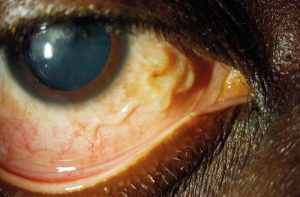 Loa loa is a parasitic filarial worm responsible for loiasis, also known as the “African eye worm.” It is transmitted to humans through the bite of the Chrysops fly (commonly known as the deer fly), which is prevalent in West and Central Africa. Once in the bloodstream, Loa loa larvae mature into adult worms that can migrate through the subcutaneous tissue. The most distinctive symptom of loiasis is the migration of the worm across the eye, which causes significant discomfort, itching, and sometimes visible movement under the skin, though it doesn’t typically cause vision loss. Other symptoms include localized swelling known as “Calabar swellings,” itching, and in some cases, pain as the worms move through the body.
Loa loa is a parasitic filarial worm responsible for loiasis, also known as the “African eye worm.” It is transmitted to humans through the bite of the Chrysops fly (commonly known as the deer fly), which is prevalent in West and Central Africa. Once in the bloodstream, Loa loa larvae mature into adult worms that can migrate through the subcutaneous tissue. The most distinctive symptom of loiasis is the migration of the worm across the eye, which causes significant discomfort, itching, and sometimes visible movement under the skin, though it doesn’t typically cause vision loss. Other symptoms include localized swelling known as “Calabar swellings,” itching, and in some cases, pain as the worms move through the body.
Treatment for loiasis typically involves antiparasitic medications like diethylcarbamazine (DEC), which kills the adult worms and microfilariae (larval stage). In cases where worms are located in sensitive areas, such as the eye, they may be surgically removed. Removing the parasite improves symptoms such as swelling, irritation, and pain. Prompt treatment also reduces the risk of complications like encephalitis (brain inflammation), which can occur when there is a high microfilarial load. Eradicating Loa loa and preventing reinfection through vector control and protective measures against fly bites can lead to better quality of life and health in endemic regions.



